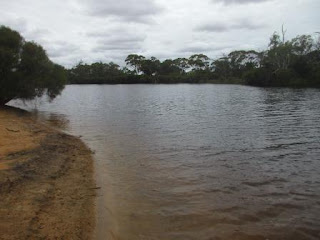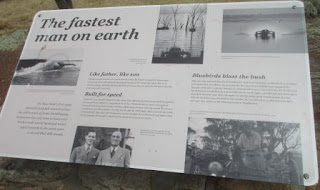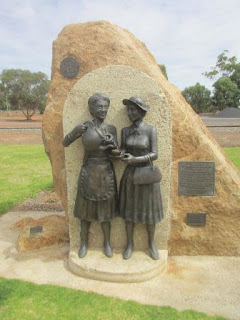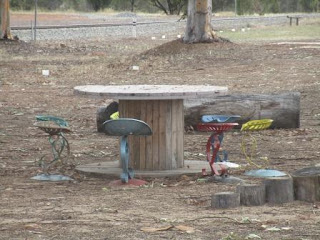8am
25 degrees, overcast and windy.
Headed
south, back through Pingelly and down to Yornaning, another old railway
townsite. There was a sign showing the school site and we could see some old
tennis courts nearby. The dam for the railway has been rejuvenated and is now a
nice picnic area.
Steve
went back to his younger days.
Next
stop was Cuballing which still has some lovely old buildings and people to live
in them. Chatted with a couple of chaps on their verandah. He had old telegraph
poles beside his front steps. He said they had been collected by Sim Metals to
sell as scrap but when the price dropped they just left them in a pile. He has
a collection of ceramic and glass insulators too.
Went
for a wander up the street. The usual – pub (1892), bank (1900s), post office
(1912), halls (1912) and a lovely church (1911) which is now a residence and up
for sale. Now this would be very nice.
Great
sculpture as we headed back onto the main road south. Up and down the little
hills, I suppose they are dunes running east-west. We are leaving the ‘ing’
ending town names and heading into the ‘in’ names.
Went
through a swarm of bees and sadly they will fly no more but they left their
honey all over our windscreen – it smelt delicious.
Headed
into Narrogin – nice entrance sign.
Narrogin
is the commercial centre for the Dryandra Country. There is the Dryandra
Woodland and Foxes Lair Nature Park to explore if you are into plants and
flowers. From 1905 Narrogin was a major rail junction for the Great Southern
Railway. I snapped a few photos of older buildings as we drove through.
The
Duke of York established 1857 obviously isn’t the original building.
Of
course the Town Hall is the grandest building.
Continued
south to Wagin – home of the Big Ram. Slowly ticking off my list of ‘big
things’ that Dad gave me.
Took
a wrong turn and ended up heading out of town and up a hill before we could
turn around – oops. Had to pull off too for two big ‘loads’.
Someone
has created an interesting display for the Woolorama.
Pulled
into the Wetlands Park where ‘Baart’ stands proudly nearby. Steve took my photo
– no bum shots for me!!
Then
we realised there was another photo spot up the hill with information.
There
is a historical village here too but we have done a few of those now in our
travels. Settlers moved into the area from 1840 and by the early 1900s with the
Great Southern Railway line built between Perth and Albany, Wagin had become
the hub of the Great Southern. It is near a series of ancient lakes and is
regarded as the most heritage rich rural town in WA. Did our drive around town
checking out the old buildings.
Headed
east to Lake Dumbleyung. Interesting sign as we drove in – we thought it meant
the grids we had to cross as we are on private property but ‘doublegees’ are
nasty prickles.
Looks
like a very big lake.
Found
the information board at the bottom of Pussy Cat Hill.
Great
map of where we have been exploring on this little trip.
Drove
up Pussy Cat Hill – don’t know how it got that name. Hope the van and truck
don’t slide down the hill on the bauxite balls. Great view from up here. Too
windy for a race today. He got his two records in the same year and we will be
seeing the two lakes of those records in one year too – here and Lake Eyre in
June.
Lots to read.
The memorial which has a hole in above the plaque that lets the light shine through onto the miniature 'Bluebird' below (the shiny dot on the plaque on the ground) at the exact time he set the world record. Amazing.
Drove
down to the Yacht Club further around the lake. This side for canoeing,
yachting and the other side for water skiing – when there is water in it of
course. Some locals were there having a canoe. They said the lake had been dry
for a long time before all the rain in February last year. He said he was only
little when Donald set the record but remembers the town was very excited and
coming out to watch. They were here for New Year too and went up to see the
beam of sunlight come through the hole in the rock on the memorial and it did
light up the ‘bluebird’ on the plaque. How wonderful.
Great
sign as we head into the town of Dumbleyung.
There
is a wonderful display of the ‘Bluebird’ replica and lots of information.
Across
the road beside the Resource Centre there is a fabulous sculpture of Donald
Campbell made out of chicken wire – it was amazing.
Went
inside and read more information. Great photo of the lake with lots of islands
when it isn’t full of water.
Outside
we checked out the information board. The shops are still here from the 1920s.
Across
the railway line the Grande Olde’ Dumbleyung Inn is being refurbished.
Old
farm machinery etc on display.
A
lovely memorial to CWA ladies.
Walked
down to the railway station – more great photos.
The
old and new photos of the Bank.
An
old photo of the Inn which was Tunney’s Hotel.
A
great tractor built in 2012 from scrap metal with a 1920 cultivator behind it
which would have been pulled with two horses.
Also
a steam loco built in 2013 from scrap metal too. Both built by Bob Bray.
In
the park were more reused farm bits.
Stopped
at the Bi-Centenary Park for a cuppa.
Great table but the seat is a bit uncomfortable.
Headed
south to Katanning.
The
Info Centre was closed but I got a booklet on the history from the library. The
town’s name was first recorded in 1880. It is home to the largest sheep sale
yards in the Southern Hemisphere with over one million sheep sold at auction
each year. It is reputed to have had the first street lights in Australia and
the first swimming pool and public lending library in country WA. In 1888
Frederick Piesse and his brother Charles planned to build a permanent store in
Katanning so the firm of F & C Piesse was founded here. In 1889 Piesse Bros
build the flour mill and the Katanning Hotel.
The
big flour mill is being refurbished – what a shame they had to put modern glass
around the bottom.
Looking
up the street with the railway on our left. The town is split down the middle
by the railway.
We
crossed the railway lines and headed down that street past the post office,
bank and hotel.
Found
a map but the buildings pictured with a letter marker weren’t marked on the map
so that wasn’t very helpful!!
Look
– a newer version of our truck!! Cleaner too.
Nice
mural.
St
Andrews Anglican Church is now a Chinese Restaurant – now that doesn’t seem
quite right.
Back
across the railway tracks.
Lots
of lovely buildings along this street. Of course most are pubs or banks.
Site
of the first school, Oct 1890.
Katanning’s
founding father – Frederick Piesse.
There
is a long railway station compared to the other towns.
Back
to the truck near the Town Hall opened May 27, 1907.
Drove
out to our stop for the night in the Lions Park RV Stop. Right next to the BMX
track – now that brings back memories.
I
walked over to the Lions Park where there were lots of flags and a great map
celebrating the many nationalities of the people who have lived or live in
Katanning.
Across
the road is a beautiful home called ‘Kobeelya’ which was the home of FH Piesse.
It was built in 1902. The name means ‘place of peace’. In 1922 it became a
boarding school for girls and closed in 1986 and it was then purchased by the
Baptist Community.
Further
down the road was a park with miniature railway and fabulous playground. Also
more information on Katanning.
Back
to the van – all quiet here.


































































































































































No comments:
Post a Comment